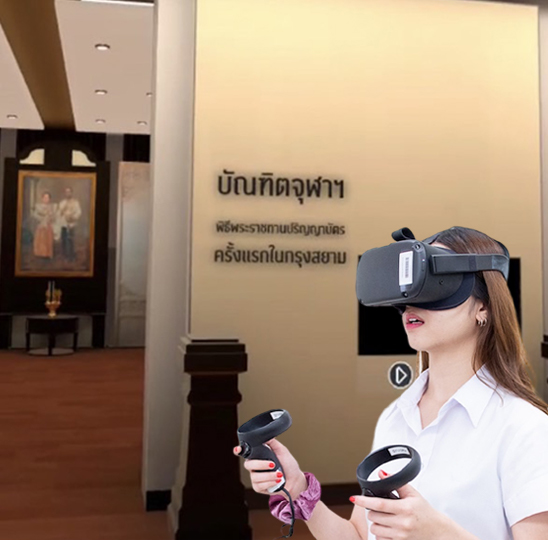Chula’s Institute of Thai Studies and the Faculty of Engineering have worked together to create “The CU Memorial Hall’s VR Program” pioneering the learning of history in three-dimensional virtual reality, rendering modernity to the past and instilling a sense of fun in the new generation.
Technology is an enabling factor today that helps to make learning an entertaining endeavor. Many of us may have thought that history is a boring subject requiring memorization but that is no longer the case today since it is through “experience” that one learns with the help of technology that helps to enliven the subject by making it more vivid.
Many interested persons have experimented with a virtual trip into the past at
Chulalongkorn University’s Central Library through the use of “The CU Memorial Hall’s VR Program.” Each person is given a VR headset and with that, they can enter the CU Memorial Hall without having to leave their seats.
“The moment I donned those VR glasses I felt like I was suddenly transported to the area at the entrance of the Memorial Hall with all the trees and greenery. I felt like I was standing at that very place.” One person who had experimented with the CU Memorial Hall’s VR program related that particular experience.
“The moment our fingers touch the controller the image changes creating the feeling that we are walking into the museum. Our fingers take us to any spot we wish to be in. Everything is so real even the mirrors have a reflection in them. The objects on display also appear in three dimensions and we can reach out and touch the object. If you wish to hear the narration of the history of the museum and the objects all you have to do is press the button on the screen.”
The CU Memorial Hall’s VR (Virtual Reality) Program is a part of the
research project entitled “The creation of virtual reality maps in the CU Memorial Hall that present its history in a 3D format via a 5G platform and above.” It marks the collaboration between the Institute of Thai Studies and the Faculty of Engineering, Chulalongkorn University. The project aims to develop the presentation of data, objects, and stories in the CU Memorial Hall to make it more interesting. The program is also a part of the “Creation of an eco-system and 5G network for Chulalongkorn University’s industrial, educational, and medical research.”
The CU Memorial Hall VR Program: A Modern Way to Present History
VR is a type of media that is used to create virtual experiences through various forms of three-dimensional techniques that have yet to be used very much for educational purposes. The research team and program developers have therefore employed modern technology as a tool to entice the new generation to appreciate what is of historical value.
“The youth of today are less interested in history. Working with these students enables us to understand their nature. We can therefore try to design educational media that is more attuned to their interests and needs.” Dr. Ratchaneekorn Ratchatakorntrakoon a researcher at the Institute of Thai Studies explained.
“We want people to understand that VR isn’t a game but a form of Edutainment (Education + Entertainment) that provides a wide range of opportunities to study any place and any time.”
Three of the concepts at the heart of the development and design of the CU Memorial Hall VR Program are:
1. Easy to understand
- the technique and content should be interesting and accessible to people of all ages.
2. Easily accessible
- the CU Memorial Hall can be accessed simply with an internet connection and VR gear.
3. Learning through experience
- the use of one’s basic senses – seeing, hearing, and touching are important factors that lead to effective learning and remembering.
“VR enables us to see images widely and clearly. We also hear the sounds clearly through the use of stereo equipment. Most importantly we can touch the objects which isn’t allowed in real museums.” Dr. Ratchaneekorn enumerated the advantages of a museum visit via VR programs.
The creation of the experience and the interaction between a virtual museum and the VR program user is at the heart of an entertaining learning experience.
“The CU Memorial Hall VR Program was designed as an interactive game between the program user and the museum itself. When the user reaches out to touch an object they will learn about its significance from the sights and sounds providing them with information making it easy to understand and remember. Each episode usually begins with a question that leads into the content for example “How was the construction of the equestrian statue of His Majesty King Chulalongkorn relevant in the founding of Siam’s first university?”
“Aside from the difference in terms of media and method of interaction between the VR and the actual exhibition, there are also differences in terms of content since the Memorial Hall periodically alters its exhibitions. The evolution of Chula student uniforms found in the VR, for example, isn’t found at the CU Memorial Hall in the Chakrabongse Building.”
CU Memorial Hall and the learning of a significant part of Thai history
The CU Memorial Hall’s VR program has been designed not only to show Chula students the historical significance of this
educational institute.
Dr. Ratchaneekorn pointed out that “As Thailand’s first university, the data we have regarding Chulalongkorn University serves the purpose not only as a record of Chula’s history but is also historically significant to Thailand as a nation.”
The CU Memorial Hall’s VR program is now open to the general public who can visit counter 1 of Chulalongkorn University’s Central Library to borrow the necessary equipment. Free downloading will also be possible soon. Any agency interested in this program can contact Dr. Ratchaneekorn by emailing her at
[email protected].
For the full release of this article and more images, please visit:
https://www.chula.ac.th/en/highlight/107778/ 